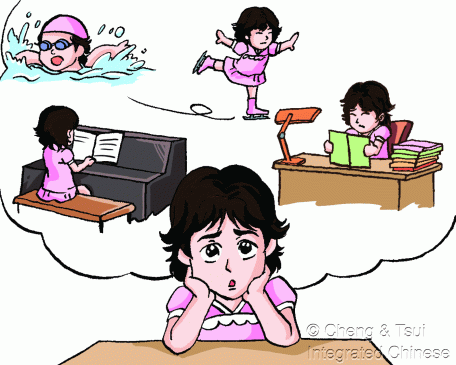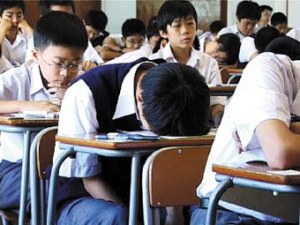“Great lesson! Can you do Saturday next week?”
“Hmm, Saturday might be difficult because I have basketball, ballet, piano and golf. Oh, and English.”
This is the answer from my 11-year-old student (who incidentally already speaks perfect English). I know better than to ask for another time on Sunday: Thai dance and maths won’t learn themselves! Yet this is not the most hectic schedule I have encountered. I used to coach two sisters for an hour each every day, after their barely awake mother zoomed them straight over from school. Afterwards, we’d grab dinner together and the kids did their homework whilst their mum shoved spoonfuls down them, lest they should pause from doing sums to feed themselves. Needless to say, this arrangement didn’t last. A new, even more demanding school meant my classes had to give way to extra Chinese, Maths and swimming lessons. The girls are already trilingual but their mum is convinced they are falling behind their classmates and frets about them having to repeat this school year. The kids are four and six.
What saddens me most is the effect this has on the girls. The fuss around these extra activities is teaching them more than how to solve equations or play Mozart. They are also learning to worry, compare themselves to others, and feel ‘not good enough’. They are learning that ‘busy’ equals ‘respect-worthy’ and exhaustion is a sign of accomplishment. The irony is that multiple studies show cramming in more lessons from earlier ages has no advantage to children’s learning rates. Conversely, it could be detrimental.

It may be a no-brainer (pardon the pun) that kids prefer to play than sit behind a desk, but learning and play needn’t be mutually exclusive. In “The Power of Play”, Dr Rachel White, researcher in Developmental Psychology, concludes “play is learning…play benefits cognitive, social, emotional, and physical development.” And “In an age where play is under siege in many educational circles, promoting opportunities for children to learn through playful contexts could not be more important.”
One country that has taken the spotlight for excellence and forward thinking in education is Finland. Yes, just when you though the land of Moomins, the Northern Lights and Father Christmas couldn’t get any better, Finland tops the board in education systems.
Finnish students consistently rank highly in PISA tests, a global assessment of 15 year olds’ education levels. Whilst test-crazed Singapore has a higher share of the world’s top students, its elitism means the gold-star students at the top come at the price of those left at the bottom. By contrast, Finnish schools are equally good across the board. It may have fewer test-topping whizz-kids, but all its children are taught to an equally high standard. No one is left behind.
Finland also has one of the highest levels of student well-being. The secret? Less school, less homework and fewer tests. The 2015 PISA results should be enough to put any parent off upping the school pressure, when you consider the high price Singapore’s test results come at:

So it is no wonder that in the 2017 Global Education Report, Singaporean students said what would most improve their education system would be “No standardized testing”.
Korea, another chart topper in exams, also shows worryingly low levels of student life-satisfaction and high student anxiety.

Whilst Finland is rated the 5th happiest country this year, South Korea comes in at 55th (Thailand is at 32). It also has one of the highest youth suicide rates in the world. In Korea it is the norm for students to study late into the night (or morning!) after a full 8.30 to 4.30pm day at school. Study centres are crammed with students from 5pm to midnight or even later. And whilst Korea tops the 2017 World Top 20 Education Poll, Finland is right up there at number 3. So with so little difference in the charts, is all that stress worth it?

Finnish kids do not start school until age seven and typically have 5 hours of classes or fewer per day. They (and their teachers) also have at least 15 minutes break time for every 45 minutes of classroom learning. Shouldn’t that mean loads more homework? Nope: Finns have the least amount of homework in the world. They typically spend just 30 minutes or less on unfinished classwork. But won’t they fail all their exams with so little study? Nope again: they don’t have exams.
Finnish schools have very few formal tests, no standardised tests and the only formal exams are sat right at the end of compulsory education, at age 16. The result? Finns are among the smartest, most innovative, and happiest people on the planet.

And not only the kids benefit; Finnish teachers teach around four classes per day, half that of teachers in the US. Who likes an overworked, stressed-out teacher? No one. Especially not 10-year-olds with the energy of three cans of Red Bull. Furthermore, teachers and students alike only have to come into school when they have classes. No class? Why sit inside when you can be exploring and learning in your own garden or home?
“Okay!” I hear you cry, “Finland is great but we can’t all just move to Helsinki, and changing the Asian “tiger mom” (or dad, for that matter) mind-set will take some work.”
Quite true. But in the words of the great Moominpappa himself, “The world is full of great and wonderful things for those who are ready for them.”
So in Part 2 you’ll find a few ways to get the ball rolling (perhaps literally) in your own back garden.
